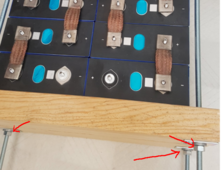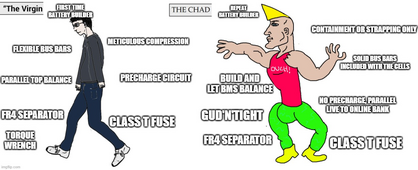kolek
Inventor of the Electron
- Joined
- Sep 29, 2021
- Messages
- 564
A DIY battery is a lot more doable if you don't stress over the details. Throw on the regular busbars that come with the battery. Grab any BMS. Don't bother to top balance. Don't use a torque wrench. Don't bother with compression. Don't build a case. Don't worry about giant sparks when you connect the battery to the inverter. Don't bother calculating the wire thickness. Maybe almost electrocute yourself a couple times. Even then the project would still suck. It would just suck a lot less.
Unfortunately, I tend to be way too much of a perfectionist, to the point of just being stupid. The net result is I get practically paralyzed trying to figure out simple things like, "what is the exact best material I should use between the cells" and I spend 3 hours researching it. When you go at it from that point of view, it's like a neverending project.
Edit: Note the above is not "advice." It's just what some people do who don't stress the details. Personally, I can't operate like this.
Unfortunately, I tend to be way too much of a perfectionist, to the point of just being stupid. The net result is I get practically paralyzed trying to figure out simple things like, "what is the exact best material I should use between the cells" and I spend 3 hours researching it. When you go at it from that point of view, it's like a neverending project.
Edit: Note the above is not "advice." It's just what some people do who don't stress the details. Personally, I can't operate like this.
Last edited:




